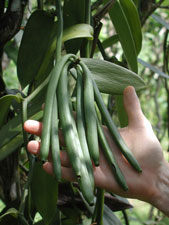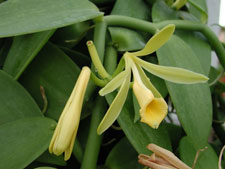Resource Library
Plant of the Week: Vanilla
The University of Arkansas System Division of Agriculture does not promote, support or recommend plants featured in "Plant of the Week." Please consult your local Extension office for plants suitable for your region.
Plant of the Week
Vanilla
Latin: (Vanilla plantifolia)

One of the earliest childhood memories I have from the middle years of the last century is the arrival of the traveling patent medicine salesman to our farmstead. He was an old man in an old car carrying and old wooden case; all were weathered with time and use.
His case opened like a tackle box with hundreds of individual compartments, each filled with mysterious shapes and exotic fragrances. Before he left, Mom always bought a bottle of vanilla extract and whatever other elixirs he could persuade her were indispensable.
Vanilla is the only orchid grown for commercial products. While four species of vanilla are sometimes grown for flavoring, the commercially important species is Vanilla plantifolia. This orchid grows as a fast growing terrestrial vine that climbs and sprawls over trees. It has 8-inch long evergreen leaves that alternate up the stem. The yellow, 3-inch wide, orchid-shaped flowers are produced in racemes containing up to 20 blooms during the winter season for the region. Individual flowers remain open for only one day.
The aromatic vanilla spice is extracted from the mahogany-colored and cigar-shaped orchid pods that can reach 8 to 10 inches in length. These take nine to 10 months to mature. The most expensive vanilla beans are picked daily from pods allowed to ripen on the vine. More commonly, they’re picked green and sweated to enhance the over 200 compounds that go into the production of the complex vanilla flavor.
Vanilla was cultivated in Mexico long before the arrival of Europeans. In the 1520s, the Spanish conquistador Hernan Cortes introduced vanilla and chocolate to Europe and changed the taste of food forever. Though French travelers transported vanilla vines to tropical regions of Africa and Madagascar in the 1600s, production remained centered in Mexico until the mid 19th century.

Like most orchids, pollination is accomplished in nature by means of a specific pollinator such as an insect called the mountain bee. The vines that were grown in the Indian Ocean region flowered but produced no fruit because the pollinator failed to become established outside of its native range. Then in 1841, a 12-year-old slave, Edmond Albius (1829 -1880), living on the Reunion Island (150 miles east of Madagascar) learned to use a blade of grass of pry open the orchid blossom and manually self-pollinate the flower. Today, Madagascar and Indonesia produce 85 percent of the world’s natural vanilla supply and still use his technique.
The main ingredient in vanilla bean is a phenolic compound called vanillin that was synthetically produced in 1874. Synthetic vanilla flavoring is still used, but purists swear by the more complex flavor and taste of the real thing. The dark specks seen in the more expensive vanilla ice cream brands are the tiny orchid seeds from the vanilla seedpod.
Vanilla is a terrestrial orchid that grows best in well-drained, acidic volcanic soils. It requires a warm and humid tropical climate for commercial production. It’s grown under shade cloth or attached to the trunk of trees where the foliage canopy provides the needed shade.
Vanilla can be grown as part of an orchid collection but usually fanciers forego this sprawling, difficult to contain plant for more showy specimens. In pots, it’s grown in a typical orchid bark medium and trained to some kind of trellis.
By: Gerald Klingaman, retired
Extension Horticulturist - Ornamentals
Extension News - November 14, 2008
The University of Arkansas System Division of Agriculture does not maintain lists of retail outlets where these plants can be purchased. Please check your local nursery or other retail outlets to ask about the availability of these plants for your growing area.